Dear Aspirants, Our IBPS Guide team is providing a new series of Reasoning Questions for bank exams so the aspirants can practice it on a daily basis. These questions are framed by our skilled experts after understanding your needs thoroughly. Aspirants can practice these new series of questions daily to familiarize themselves with the exact exam pattern and make their preparation effective.
Parallel Row Seating Arrangement Questions PDF for Bank Exams: The parallel row seating arrangement questions pdf contains essential types of questions frequently asked in competitive exams. Parallel row seating arrangement easy-level questions are included in the parallel row seating arrangement pdf for bank exams which helps the candidates to score good marks in parallel row seating arrangement questions for IBPS Clerk. From the given questions, the candidates need to place all persons in a straight line either in the north direction or the south direction. In some questions of the parallel row seating arrangement puzzle pdf, the persons are placed in mixed directions. The level of difficulty is higher in parallel row seating arrangement questions for SBI PO mains when compared with parallel row seating arrangement questions for IBPS PO. Candidates can also get a parallel row seating arrangement list for parallel row seating arrangement facing north in a single row, parallel row seating arrangement facing north and south pdf, parallel row seating arrangement tricks, parallel row seating arrangement in Hindi, parallel row seating arrangement LIC AAO, and parallel row seating arrangement for bank PO.
Parallel Row Seating Arrangement
The majority of banking examinations consist of at least two to three sets of questions based on parallel row seating arrangement. Due to its weightage in the examination, this parallel row seating arrangement questions for bank exams plays an important role in scoring high marks. All the competitive examinations containing logical reasoning consist of parallel row seating arrangement questions for bank exams. Parallel row seating arrangement is a process of arrangement of objects or persons in two or more straight parallel rows. This sort of arrangement is known as Seating Arrangement. One parallel row seating arrangement question is followed by five to six subquestions, this helps in scoring bulk marks in the exam. Hence, solving single parallel row seating arrangement questions for bank exams will boost the exam score.
Parallel Row Seating Arrangement Questions with Answers PDF
Solving parallel row seating arrangement questions and answers pdf helps the candidate to understand the parallel row seating arrangement level questions asked in linear seating arrangement reasoning questions. Parallel row seating arrangement questions with answers will help to observe the parallel row seating arrangement’s logical reasoning. The parallel row seating arrangement basic questions pdf will help to understand the basic parallel row seating arrangement formula like the question should be started with the most repeated variable. Repeated variable helps in avoiding more possibilities. Then should take the fixed information one by one correctly. This will make the parallel row seating arrangement mcq easy to solve. The parallel row seating arrangement online test includes two parallel rows seating arrangement questions pdf or more parallel row seating arrangement questions with solutions. New pattern parallel row seating arrangement questions pdf in Hindi and English are provided in the parallel row seating arrangement pdf. Scoring maximum marks in the parallel row seating arrangement questions pdf will help to increase the level of confidence in the parallel row seating arrangement mock test.
Download parallel row seating arrangement questions and answers pdf
Also, we will update the Parallel Row Seating Arrangement questions pdf and Parallel Row Seating Arrangement quiz daily in the below table. Candidates can download this Parallel Row Seating Arrangement questions pdf to practice regularly. You can attempt the daily Parallel Row Seating Arrangement test by clicking the take test link provided in the following table.
| Parallel Row Seating Arrangement Questions For Bank Exams – Daily Quiiz | ||
| Day 1 | Parallel Row Seating Arrangement Questions PDF | Take Test |
| Day 2 | Parallel Row Seating Arrangement Questions PDF | Take Test |
| Day 3 | Parallel Row Seating Arrangement Questions PDF | Take Test |
| Day 4 | Parallel Row Seating Arrangement Questions PDF | Take Test |
Parallel Row Seating Arrangement Questions PDF
Parallel line seating arrangement questions pdf is a type of seating arrangement where the persons or things are arranged in the correct sequence in two parallel straight lines. Depending on the parallel row seating arrangement questions pdf, the candidates should arrange the given persons or things in two rows or as many rows as asked in the parallel row seating arrangement reasoning questions. How can a discussion be fulfilled without mentioning the types of parallel row seating arrangements? This parallel row seating arrangement questions pdf contains different types of parallel row arrangement examples like the questions asked in parallel row seating arrangement for bank exams. So the most common types of parallel row seating arrangement questions PDF asked in various competitive tests are
Unidirectional parallel row: This type of parallel row seating arrangement questions pdf arranges persons or things in two or more rows in one particular direction (either all are North or all are South) with no diversions.
Bidirectional parallel row: This type of parallel row seating arrangement questions pdf arranges persons or things in two or more rows but they will face 2 different directions (either North or South).
Quantitative Aptitude Free PDFs
Parallel Row Seating Arrangement Tricks
On solving the parallel row seating arrangement questions pdf, the candidates will get the parallel row seating arrangement tricks and tips. Read the parallel row seating arrangement tricks completely to get strong on the parallel row seating arrangement questions. A parallel row seating arrangement is a type of sitting arrangement where the persons or things are arranged in two or more straight parallel lines. Candidates should arrange the things or persons in as many rows as mentioned in the specified question. Candidates should find the exact position of the person or a thing by solving the information given in the parallel line seating arrangement questions pdf. Let us discuss the important parallel row seating arrangement tricks to solve the seating arrangement questions.
- Find the number of rows in the parallel row seating arrangement.
- Try to find the total number of persons or things in the given arrangement.
- Then determine the orientation of the persons or things (either North or South).
- Find the repeated variables and fix their positions in the row.
- Find the fixed variable and place its position in the given row.
- The main thing is trying to reduce as many possibilities as possible and fix the position of the persons or things according to the given question.
This will help the candidate to solve the parallel row seating arrangement question pdf in an easy method. By solving more questions, the candidates will be able to get a unique idea for solving the parallel row seating arrangement reasoning questions.
Direction (1-5): Study the following information carefully and answer the questions given below.
Ten persons are sitting in two parallel rows and facing towards each other. In row1 P, Q, R, S and T are sitting and all of them face north. In row2 U, V, W, X and Y are sitting and all of them face south.
The one who faces V sits third to the left of Q. U sits second to the left of V. Only one person sits between T and the one who faces U. The number of persons sitting to the left of X is same as the number of persons sitting to the right of R. S sits third to the right of R. W does not face Q. Y does not sit at the extreme end of the row
1) Who among the following person sits at the right end in row2?
A.X
B.The one who sits immediate right of W
C.T
D.The one who sits second to the right of U
E.None of these
2) Who among the following person sits third to the left of the one who faces Y?
A.S
B.The one who sits second to the left of P
C.Q
D.The one who sits to the immediate right of T
E.None of these
3) Four of the following five are alike in a certain way as per the given arrangement and hence form a group. Find the one that does not belong to that group.
A.S and Y
B.U and Q
C.T and X
D.V and R
E.P and W
4) What is the position of S with respect to Q?
A.Third to the right
B.Immediate right
C.Fourth to the right
D.Second to the left
E.Immediate left
5) Who among the following person faces P?
A.W
B.V
C.U
D.Y
E.X
Direction (6-10): Study the following information carefully and answer the questions given below
Twelve students are seated on the school ground and opposite to each other. In row1, A, B, C, D, E, and F are facing south. In row2- U, V, W, X, Y and Z are facing north. All the information is not necessarily in the same order.
E sits opposite to the one who sits third to the left of X, either of them sits at the end of the row. Only one person sits between E and F. The number of persons sitting to the left of F is the same as to the right of Z. Only two persons sit between Z and the one who sits opposite to A. The number of persons sitting between A and F is the same as between Y and U. Y and Z are not immediate neighbours.W sits to the right of V and does not face A. C sits to the left of D but sits to the right of B.
6) Who among the following person faces the one who sits to the immediate left of C?
A.The one who sits second to the right of X
B.The one who sits immediate left of V
C.Z
D.W
E.U
7) How many persons sit between Y and the one who faces F?
A.None
B.Four
C.Two
D.One
E.Three
8) Four of the following five are alike in a certain way as per the given arrangement and hence form a group. Find the one who doesn’t belong to that group?
A.YW
B.UX
C.DE
D.CB
E.AF
9) If all the persons are made to sit in alphabetical order in Row 2, from the left end to the right end, then how many persons remain unchanged in their position?
A.None
B.Two
C.One
D.Three
E.Four
10) Who among the following persons its adjacent to F?
I) The one who faces X
II)The one who faces U
III) The one who faces V
A.Only (I) and (II)
B.Only (II) and (III)
C.Only (III)
D.Only (II)
E.Only (I) and (III)
Try Seating Arrangement Questions For Online Mock Test
Answers :
Directions (1-5) :
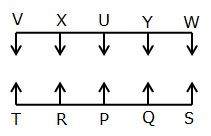
We have,
- The one who faces V sits third to the left of Q.
- U sits second to the left of V.
From the above conditions, there are two possibilities.

Again we have,
- Only one person sits between T and the one who faces U.
- The number of persons sitting to the left of X is same as the number of persons sitting to the right of R.
- S sits third to the right of R.
From the above conditions, Case1a is formed and Case1 gets eliminated.
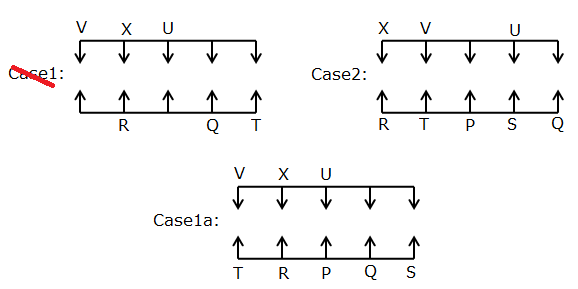
Again we have,
- W does not face Q.
- Y does not sit at the extreme end of the row.
From the above conditions, Case2 gets eliminated. Hence Case1a shows the final arrangement.

1) Answer: D
2) Answer: B
3) Answer: E
4) Answer: B
5) Answer: C
Directions (6-10) :
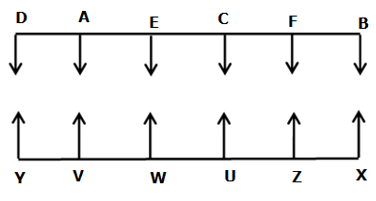
We have,
- E sits opposite to the one who sits third to the left of X, either of them sits at the end of the row.
From the above condition, there are two possibilities.

Again we have,
- Only one person sits between E and F.
- The number of persons sitting to the left of F is the same as to the right of Z.
From the above condition, there are three possibilities.
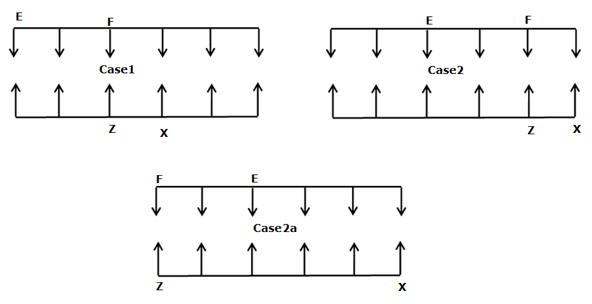
Again we have,
- Only two persons sit between Z and the one who sits opposite to A.
- The number of persons who sits between A and F is the same as between Y and U.
- Y and Z are not immediate neighbors.
- W sits to the right of V and does not face A.
From the above condition, case1 and case2a get eliminated.
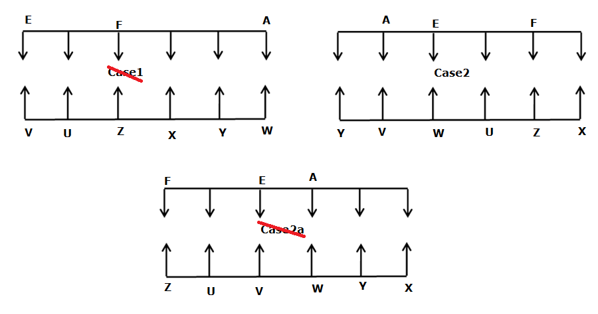
Again we have,
- C sitsto the left of D but sits to the right of B.
From the above condition, case2 shows the final arrangement.
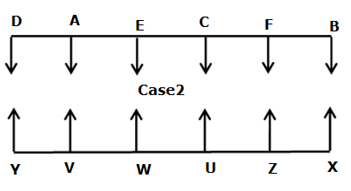
6) Answer: C
7) Answer: E
8) Answer: E (More than one person sits between A and F)
9) Answer: B
10) Answer: A
Direction (11-15): Study the following information carefully and answer the questions given below.
Eight persons are sitting in two parallel rows facing towards each other. In row 1 – J, K, L, and M are sitting and facing towards north while in row 2 – P, Q, R, and S are sitting and facing towards south, but not necessarily in the same order. They like different fruits – Kiwi, Mango, Apple, Grapes, Guava, Orange, Papaya and Rambutan.
Only one person sits between J and the one who faces the one who likes papaya, who doesn’t sit at the ends of the row. M sits immediate right of the one who faces the one who likes papaya. Only one person sits between Q and the one who faces M. P is the only neighbour of the one who faces the one who likes mango, who doesn’t face Q. L sits second to the left of the one who faces the one who likes kiwi, which is not liked by R. The one who likes apple sits to the left of L, who doesn’t like orange. M neither likes grapes nor rambutan. As many persons sit to the right of K as to the left of the one who likes orange.
11) Who among the following person likes Kiwi?
A.The one who sits second to the right of S
B.The one who sits immediate right of K
C.The one who sits facing towards the one who likes Mango
D.Q
E.None of these
12) Who among the following person sits immediate right of J?
A.The one who likes apple
B.M
C.The one who likes Papaya
D.No one
E.None of these
13) Which among the following is the correct combination?
A.J − Mango
B.Q − Grapes
C.R − Rambutan
D.M − Apple
E.None of these
14) If the person who faces M likes Rambutan fruit, then L likes which of the following fruit?
A.Guava
B.Orange
C.Grapes
D.Apple
E.Mango
15) Who among the following person sits second to the right of the one who faces the one who likes Papaya?
A.The one who faces Q
B.L
C.M
D.The one who faces S
E.None of these
Direction (16-20): Study the following information carefully and answer the b questions given below.
Twelve students are sitting in two parallel rows on the school ground opposite to each other. A, B, C, D, E, and F are sitting in row 1 and facing towards South while U, V, W, X, Y and Z are sitting in row 2 and facing towards North, but not necessarily in the same order.
E sits opposite to the one who sits third to the left of X. Either E or X sits at the end of the row. Only one person sits between E and F. As many persons sit to the left of F is same as to the right of Z. Only two persons sit between Z and the one who sits opposite to A. Only two persons sit between Y and U. Both Y and Z are not immediate neighbors. W sits to the right of V but doesn’t face A. C sits to the left of D and right of B.
16) Who among the following person faces the one who sits immediate left of C?
A.The one who sits second to the right of X
B.The one who sits immediate left of V
C.The one who sits fourth to the right of Y
D.W
E.U
17) How many persons sit between Y and the one who faces F?
A.None
B. Four
C.Two
D.One
E.Three
18) Four of the following five are alike in a certain way as per the given arrangement and hence form a group. Find the one who doesn’t belong to that group.
A.YW
B.UX
C.DE
D.CB
E.AF
19) If all the persons are arranged in alphabetical order in row 2 from left to right, then how many persons remain unchanged in their position?
A.None
B.Two
C.One
D.Three
E.Four
20) Who among the following person sits adjacent to F?
I)The one who faces X
II)The one who faces U
III) The one who faces V
A.Only (I) and (II)
B.Only (II) and (III)
C.Only (III)
D.Only (II)
E.Only (I) and (III)
Try Seating Arrangement Questions For Online Mock Test
Answers :
Directions (11-15) :
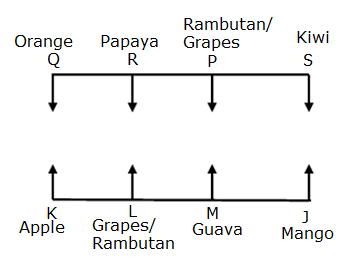
We have,
- Only one person sits between J and the one who faces the one who likes papaya, who doesn’t sit at the ends of the row.
- M sits immediate right of the one who faces the one who likes papaya
From this condition, there are two possibilities

Again we have,
- Only one person sits between Q and the one who faces M.
- P is the only neighbour of the one who faces the one who likes mango, who doesn’t face Q.
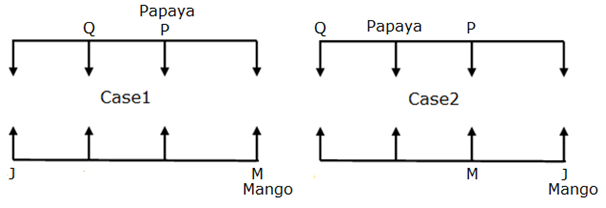
Again we have,
- L sits second to the left of the one who faces the one who likes kiwi, which is not liked by R.
- The one who likes apple sits to the left of L, who doesn’t like orange.
- M neither likes grapes nor rambutan.
- As many persons sit to the right of K as to the left of the one who likes orange
From the above condition, case 1 gets eliminated. Hence, case 2 shows the final arrangement.
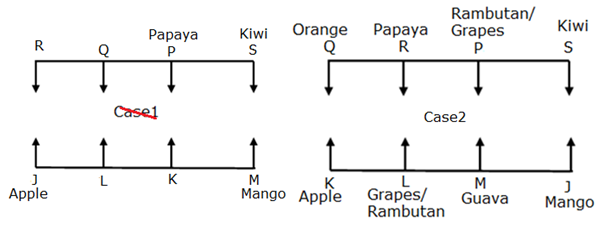
11) Answer: C
12) Answer: D
13) Answer: A
14) Answer: C
15) Answer: D
Directions (16-20) :
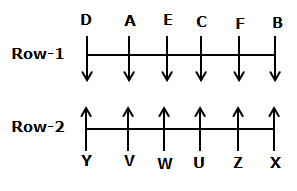
We have,
- E sits opposite to the one who sits third to the left of X.
- Either E or X sits at the end of the row.
- Only one person sits between E and F.
- As many persons sit to the left of F is same as to the right of Z.
From the above conditions, there are three possibilities.

Again we have,
- Only two persons sit between Z and the one who sits opposite to A.
- Only two persons sit between Y and U.
- Both Y and Z are not immediate neighbors.
- W sits to the right of V but doesn’t face A.
- C sits to the left of D and right of B.
So case1 and case3 get eliminated. Hence Case2 shows the final arrangement.

16) Answer: C
17) Answer: E
18) Answer: E (In all the options, only one person sits between both the persons, except option e)
19) Answer: B
20) Answer: A





